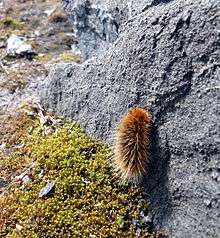Gynaephora groenlandica
| Arctic woolly bear moth | |
|---|---|
 | |
| Arctic woolly bear caterpillar, Baffin Island | |
| Scientific classification | |
| Kingdom: | Animalia |
| Phylum: | Arthropoda |
| Class: | Insecta |
| Order: | Lepidoptera |
| Family: | Lymantriidae |
| Genus: | Gynaephora Hübner, 1819 |
| Binomial name | |
| Gynaephora groenlandica (Wocke, 1874) | |
Gynaephora groenlandica, the arctic woolly bear moth, is a lymantriid moth found within the Arctic Circle, in Greenland and Canada. It is best known for its very slow rate of development. It was once estimated that it had a 14-year lifecycle from egg to adult moth, unique among the Lepidoptera with the ability to withstand temperatures below −60°C. The larvae degrade their mitochondria in preparation for overwintering and resynthesize them in the spring, and each instar of the caterpillar takes about a year. Subsequent studies have revised the lifecycle duration to be 7 years.[1]
The Arctic woolly bear caterpillars are unique in their combination of adaptations to the polar extremes. They spend nearly 90% of their lives frozen and only about 5% feeding on the tundra during June; the remainder is spent in summer aestivation within hibernacula (protective cocoons).
Hiding within hibernacula serves several functions: protection from insect parasitoids that kill about 75% of the larvae and pupae, avoidance of secondary metabolites built up in their food source, the Arctic willow, degradation of mitochondria linked to hypometabolism and antifreeze synthesis, and conservation of energy reserves needed to synthesize cryoprotective compounds required for freezing survival.
Two insect parasitoids attack woolly bear moth caterpillars: an ichneumonid wasp (reported as Hyposoter pectinatus but probably Hyposoter deichmanni[2]) and a tachinid fly (Exorista thula[3]). The wasp, a solitary parasitoid, kills about 20% of the third and fourth instars of the host while the gregarious bristle fly causes about 50% mortality in the instar 5 and 6, and pupae.
The extreme winter temperatures are not as detrimental to Gynaephora caterpillars as are the parasitoids. The larvae are extremely freeze-tolerant, able to survive temperatures down to -70°C. As temperatures decrease during the late arctic summer, the larvae start synthesizing cryoprotective compounds, such as glycerol, in addition to some unusual ones, e.g. betaine. Accumulation of these "antifreezes“ is aided by bottle-necking of oxidative phosphorylation through mitochondrial degradation. The woolly bears resynthesize the mitochondria the following spring upon resumption of their activity.
The Natural History Unit of the BBC filmed arctic woolly bear moths in their natural habitat on Ellesmere Island during June 2009. The sequence became part of the BBC's sequel to Planet Earth called Frozen Planet, broadcast on BBC One in autumn 2011 (with the US broadcast following on Discovery Channel in spring 2012).[4]
References
- ↑ Morewood, W. Dean; Richard A. Ring (1998). "Revision of the life history of the High Arctic moth Gynaephora groenlandica (Wocke) (Lepidoptera: Lymantriidae)". Canadian Journal of Zoology. 76 (7): 1371–1381. doi:10.1139/cjz-76-7-1371.
- ↑ Varkonyi, Gergely; Tomas Roslin (2013). "Freezing cold yet diverse: dissecting a high-Arctic parasitoid community associated with Lepidoptera hosts". Canadian Entomologist. 145: 193–218. doi:10.4039/tce.2013.9.
- ↑ Morewood, W. Dean; D. Monty Wood (2002). "Host utilization by Exorista thula Wood (sp. nov.) and Chetogena gelida (Coquillett) (Diptera: Tachinidae), parasitoids of arctic Gynaephora species (Lepidoptera: Lymantriidae)". Polar Biology. 25: 575–582. doi:10.1007/s00300-002-0382-y.
- ↑ Levin, Gary (April 8, 2008). "Another sweeping nature special when 'Planet' freezes over". USA Today. Retrieved May 25, 2010.
Further reading
- Bernd Heinrich (1993). The hot-blooded insects: strategies and mechanisms of thermoregulation. Harvard University Press.
- R. F. Chapman (1998). The insects: structure and function. Cambridge University Press. ISBN 978-0-521-57890-5.
- Kukal, O. and P.G. Kevan. (1987) The influence of parasitism on the life history of a high arctic insect, Gynaephora groenlandica (Wöcke) (Lepidoptera: Lymantriidae). Can. J. Zool. 65: 156-163.
- Kukal, O. 1988. Caterpillars on ice. Natural History 97: 36-41.
- Kukal, O., Duman, J.G. and A.S. Serianni. (1988) Glycerol metabolism in a freeze-tolerant arctic insect: An in vivo 13-C NMR study. J. Comp. Physiol. B 158: 175-183.
- Kukal, O., Heinrich, B. and J.G. Duman. (1988) Behavioural thermoregulation in the freeze-tolerant arctic caterpillar, Gynaephora groenlandica. J. Exp. Biol. 138: 181-193.
- Kukal, O. and T.E. Dawson. (1989) Temperature and food quality influences feeding behavior, assimilation efficiency and growth rate of arctic woolly-bear caterpillars. Oecologia 79: 526-532.
- Kukal, O., Duman, J.G. and A.S. Serianni. (1989) Cold-induced mitochondrial degradation and cryoprotectant synthesis in freeze-tolerant arctic caterpillars. J. Comp. Physiol. B 158: 661-671.
- Kukal, O. 1990. Energy budget for activity of a high arctic insect, Gynaephora groenlandica (Wöcke) (Lepidoptera: Lymantriidae). In: C.R. Harington (ed) Canadian Arctic Islands: Canada's Missing Dimension. National Museum of Natural History, Ottawa, Canada.
- Kukal, O. 1991. Behavioral and physiological adaptations to cold in a freeze-tolerant arctic insect. In: R.E. Lee and D.L. Denlinger (eds) Insects at Low Temperature. Chapman and Hall, N.Y.
- Kukal, O. 1993. Biotic and abiotic constraints on foraging of arctic caterpillars. In: N.E. Stamp and T.M. Casey (eds) Caterpillars: Ecological and Evolutionary Constraints on Foraging. Chapman and Hall, N.Y.
- Kevan, P.G. and O. Kukal. (1993) A balanced life table for Gynaephora groenlandica (Lepidoptera: Lymantriidae) a long-lived high arctic insect, and implications for the stability of its populations. Can. J. Zool. 65: 156-163.
- Danks, H.V., Kukal, O. and R.A. Ring. (1994) Insect cold-hardiness: Insights from the arctic. Arctic 47 (4): 391-404.
- Kukal, O. (1995) Winter mortality and the function of larval hibernacula during the 14-year life cycle of an arctic moth, Gynaephora groenlandica. Can. J. Zool. 73: 657-662.
- Bennett, V. A, Kukal, O. and R.E. Lee. (1999) Metabolic opportunists: Feeding and temperature influence the rate and pattern of respiration in the high arctic woollybear caterpillar, Gynaephora groenlandica (Lymantriidae). J. Exp. Biol. 202: 47-53.
- Bennett, V.A., Lee, R. E., Jr., Nauman, J.S. and Kukal, O. (2003) Selection of overwintering microhabitats used by the arctic woollybear caterpillar, Gynaephora groenlandica. CryoLetters 24(3): 191-200.